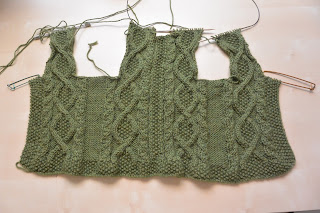Modular Arithmetic: This particular cardigan has an 18-row cable pattern that repeats several times beginning with row 9 of the sweater body, while at the same time you knit a buttonhole every tenth row beginning in row 5. So I know that I need to put a buttonhole in row 5, 15, 25, 35, and 45. I want to start counting my rows with row 1 of the CABLE PATTERN, so using the new numbering system for rows, I'll be putting buttonholes in row 7 (this is the second buttonhole), 17, 27, and 37. Then using modular arithmetic (also known as clock arithmetic) I reduce those modulo 18 and work buttonholes in rows 7, 17, 9, and 1 of the CABLE PATTERN. For me, this is much easier than trying to keep track of one count for the cable pattern and another for the buttonholes - instead, I just track everything in terms of the cable pattern.
Sunday, December 13, 2015
Being a mathematician improves my knitting
Modular Arithmetic: This particular cardigan has an 18-row cable pattern that repeats several times beginning with row 9 of the sweater body, while at the same time you knit a buttonhole every tenth row beginning in row 5. So I know that I need to put a buttonhole in row 5, 15, 25, 35, and 45. I want to start counting my rows with row 1 of the CABLE PATTERN, so using the new numbering system for rows, I'll be putting buttonholes in row 7 (this is the second buttonhole), 17, 27, and 37. Then using modular arithmetic (also known as clock arithmetic) I reduce those modulo 18 and work buttonholes in rows 7, 17, 9, and 1 of the CABLE PATTERN. For me, this is much easier than trying to keep track of one count for the cable pattern and another for the buttonholes - instead, I just track everything in terms of the cable pattern.
Labels:
baby things,
cables,
knitting,
math,
sweaters
Subscribe to:
Post Comments (Atom)


No comments:
Post a Comment